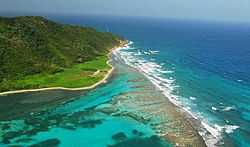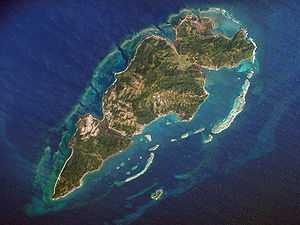Guanaja
| Guanaja | |
|---|---|
 | |
 Guanaja | |
| Coordinates: 16°28′N 85°53′W / 16.467°N 85.883°W | |
| Country | Honduras |
| Department | Islas de la Bahía |

Guanaja is one of the Bay Islands of Honduras and is in the Caribbean. It is about 70 kilometres (43 mi) off the north coast of Honduras, and 12 kilometres (7.5 mi) from the island of Roatan. One of the cays off Guanaja, also called Guanaja or Bonnaca or Low Cay (or just simply, The Cay), is near the main island, and contains most of the approximately 10,000 people who live in Guanaja. The densely populated cay has been described as the Venice of Honduras because of the waterways that run through it.[citation needed] The other two main settlements on Guanaja are Mangrove Bight and Savannah Bight. Smaller settlements include East End and North East Bight.
The primary source of income for the islanders is fishing and shrimping. Tourism is confined to a handful of small resorts that cater to divers, snorkelers and adventure travelers. The island's warm, clear waters support an extensive coral reef that is part of the Mesoamerican Barrier Reef and second only to the Great Barrier Reef off the coasts of Australia. Currently, there is still access to fresh water on Guanaja, and several waterfalls can be seen.
History

Guanaja was discovered by Christopher Columbus on his fourth voyage in 1502. Notably, this was the first time he came across cacao, which is the core of chocolate. He landed on Soldado Beach on the north side of the island. In later years Cayman Islanders settled in the Bay Islands, which explains the diffusion of Spanish and English language.
Homer Hickam, author of Rocket Boys/October Sky, was one of the first scuba explorers of Guanaja, first visiting in 1973. Along with a team of other scuba explorers, he extensively mapped the reef system around the island for sport divers. He still owns property on the northeast end of the island.
In late October 1998, most of the buildings and homes on the island were destroyed by Hurricane Mitch. The islanders have since rebuilt, and although there are still repercussions to the economy from Mitch, tourism has been recovering. The majority of the mangrove and pine forests, which were destroyed as a direct consequence of the passage of the hurricane sweeping across the island for two days, are slowly making a comeback.
Guanaja, also known as:
- Caguamara 1600
- Isla Pinos 1600
- Guanaca 1601
- Guanaia 1657
- Guanaja 1749
- Bonaccao 1771
- Bonacca 1779
Inhabited by the Payans Indian, Christopher Columbus landed 30 July 1502, Pedro Moreno landed in 1524, Spanish slaves raids 1516–1526, buccaneering during 16th and 17th century and removal of Indians to Golfo Dulc. British Colony of Bay Islands 1852. Ceded to The Republic of Honduras 1861.
Brief History of the settlers of Guanaja In 1502 Columbus discovered this islands and called it Isla de Los Pinos (Isle of Pines) but this island already had a name, this name was Guanaca given to the land by the natives that inhabited it. As early as 1511 on a map drawn by Peter Martyr this name appears and it was later corrupted by English pirates and privateers and settlers and it was pronounced Bonacca. This name does not apply to any one part of the island but it is the named used by us when referring to the whole island. There have been other names placed on the island over the years before the Bay Islands were turned over to Honduras, the English the Dutch and the Spaniards modified the name to their liking. Upon gaining possession of the Bay Island the Honduran government made Guanaja the official name of the island but we maintained the old name for as long as we could and all the older heads throughout the islands still refer to our island as Bonacca. The main settlement is called The Cay and that’s an abbreviation of the original name Lower Cays. It was first settled by the Haylocks and it was quite by accident because they move to the two little cays that lay about a half kilometer off the south shore of the main island to get rid of the flies that plagued them during calm nights. They eventually stayed and later they sold the southernmost cay (Hog Cay) to the Kirkconnells. The Bordens, the Phillips, the Woods and many others came later and by the 1880s they had a thriving community. The village of Savana Bight was founded by families from Olancho; they were the Escalantes, Peraltas and Zunigas and later the Watlers from Caymans. Later on and also from grand Caymans came the Tatums, the Merrens, the Bennetts, the Forbes and others, these people set up residences east of Savana Bight and called it East End. The Parchmont inhabited some the upper Cays. The first to establish themselves in North East Bight were the Ebanks, the Hydes and the Greenwoods. Angelo Elwin, son of the first magistrate of the Bay Island with residence in Roatan, was the first person to settle on the upper north side of the island. Angelo Elwin‘s bride was a Moore and three or four of her brothers followed her from Barbarat to Bonacca. The Moores like the Elwins came to the Islands from Belize. Unlike other settlers Angelo Elvin had legitimate documentation deeding him the land between Michael’s Rock and Lower end of the Bay. The deeds were granted to him and signed by the authorities in Roatan. The Moores acquired properties from Angelo Elwin and built their homes in what is now called Mangrove Bight. And they were joined later by the Powerys and much later the Johnsons and the Jacksons. Writing by Alfonso B. Ebanks
Climate
| Climate data for Guanaja | |||||||||||||
|---|---|---|---|---|---|---|---|---|---|---|---|---|---|
| Month | Jan | Feb | Mar | Apr | May | Jun | Jul | Aug | Sep | Oct | Nov | Dec | Year |
| Average high °C (°F) | 28 (82) |
28 (83) |
30 (86) |
31 (87) |
31 (88) |
32 (89) |
31 (88) |
31 (88) |
32 (89) |
30 (86) |
29 (85) |
29 (84) |
30.2 (86.3) |
| Average low °C (°F) | 25 (77) |
25 (77) |
26 (78) |
27 (80) |
27 (81) |
28 (82) |
27 (81) |
28 (82) |
28 (82) |
27 (80) |
26 (78) |
25 (77) |
26.6 (79.6) |
| Precipitation mm (inches) | 218 (8.6) |
119 (4.7) |
81 (3.2) |
58 (2.3) |
69 (2.7) |
147 (5.8) |
264 (10.4) |
175 (6.9) |
155 (6.1) |
452 (17.8) |
417 (16.4) |
360 (14) |
2,515 (98.9) |
| Source: Weatherbase [1] | |||||||||||||
Demographics
Caracoles
The Caracol people are an English-speaking people who have been established in Northern Honduras (specifically, the Bay Islands) since the early 19th century and are mainly of European British-Caribbean descent. Caracol is a Spanish term that literally translates as conch, snail or shell and relates the people of the Bay Islands to their unique environment and their seafaring culture.
English is the first language of all native islanders regardless of race and Spanish is spoken second, whereas mainland Honduras is primarily Spanish speaking. It remains this way because of the islands past as a British colony as well as all islanders being the descendants of the British Isles. With the steady influx of mainland Hondurans migrating to the islands an increase in Spanish has arisen but because of the tourism and cruise ship industry that support the islands, English continues and will remain to be the first spoken and dominant language among all native island peoples. Over time the form of English spoken by the Caracol has changed. The language differs mostly in morphology but also in pronunciation and accent and, to a lesser extent, in syntax and vocabulary, from the English of the other British Caribbean colonies. Evidenced by the usage of the wide variety of old standard English terms and words that are used throughout the islands. They are similar enough to be mutually intelligible and understood throughout the entire Bay Islands. The language can also be learned, although it is not taught in the general sense, whilst the accent derived from the wide variety of expatriates living and working on the Islands from North America and Europe.
Transportation
Transportation is sparse, and as of 2006, there were only three cars on the island, but by the end of 2011, there were roughly 40. While there is only one road, from Mangrove Bight to Savannah Bight, the most common means of transportation are boats. A channel locally known as "The Canal" allows access from the south to the north side of the island without having to go all the way around. Guanaja is served by the Guanaja Airport (GJA). –− As of 2011, access to Guanaja is only by air flights from the Honduran mainland town of La Ceiba and a twice-weekly ferry from Trujillo. Along with private boats and charter planes, there are now flights from Roatan to Guanaja daily.
Currently, the main transportation is limited to boats. There are some cars and small motorcycles for rent but the road is only two miles long.
It is highly recommended that you hike to the top of the island, where you can clearly see the coast line (on a clear day) as well as getting the full perspective of the entire island and surrounding reef. A beautiful nature hike also available to the waterfall located on the North side of the Island.
References
- ↑ "Weatherbase: Historical Weather for Guanaja, Honduras". Weatherbase. 2011. Retrieved on November 24, 2011.
External links
- Guanaja Island at NASA Earth Observatory
- Guanaja Guide - island travel guide site. Learn more about the island hotels and resorts, real estate, weather, map, location, local news, local information, and things to do like diving on your next vacation.
- https://www.facebook.com/pages/Guanaja-Conch-Festival/422806991085092
This Facebook page offers full information on the Annual Conch Festival, that is celebrated since 2007. The Mayor of Guanaja Richmond Hurlston 5years ago started this Community Festival as a tradition to celebrate the history and culture of Guanaja.
This Facebook page offers information on the Annual Guanaja fishing tournament, the tournament is a non profit organization all proceeds is donated to fundraising of Bonacca Medical Center.
Coordinates: 16°28′N 85°53′W / 16.467°N 85.883°W
| ||||||||